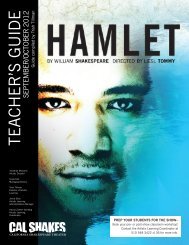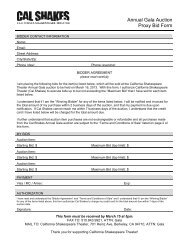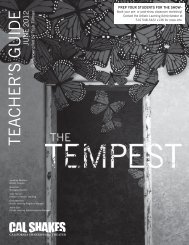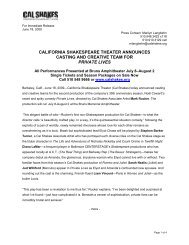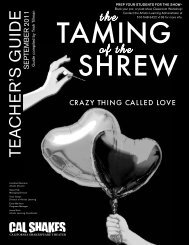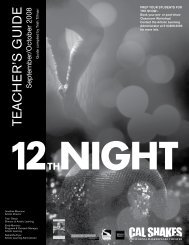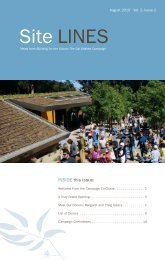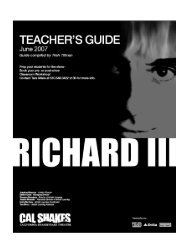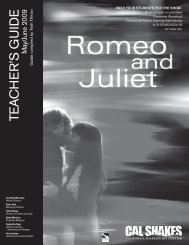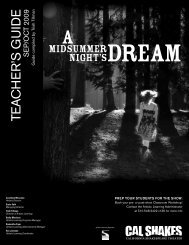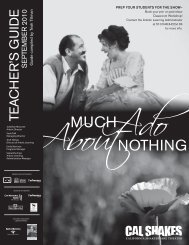Read Spunk Program - California Shakespeare Theater
Read Spunk Program - California Shakespeare Theater
Read Spunk Program - California Shakespeare Theater
You also want an ePaper? Increase the reach of your titles
YUMPU automatically turns print PDFs into web optimized ePapers that Google loves.
<strong>Spunk</strong> takes us from the rural South to the streets of Harlem, and fi nally<br />
to a more suburbanized small-town life, tracing, in part, the real-life<br />
Great Migration of African-Americans from the Jim Crow South to the<br />
industrialized North in the early 20th century. This journey is often portrayed as<br />
a modern-day Exodus, a journey from the cradle of American slavery to the free<br />
North. When the unfulfi lled promise of Reconstruction was replaced by the specter<br />
of Jim Crow laws and the indentured servitude of sharecropping, blacks left the<br />
South in record numbers by train, boat, car, and even by foot. It is estimated that<br />
during the Great Migration of the 1910s, anywhere from a few hundred thousand<br />
to more than one million blacks abandoned the South for the “free” North.<br />
Racial violence—whether the social mores requiring them to observe a lifelong<br />
deference of white people, the existential fear of unsympathetic law enforcement,<br />
the Ku Klux Klan (which surged in popularity after its heroic portrayal in D.W.<br />
Griffi th’s 1915 fi lm The Birth of a Nation), or lynching—was a decisive factor for<br />
many black migrants. But there were other reasons as well. Pittsburgh’s steel<br />
mills and Detroit’s automotive factories offered higher wages than the South’s<br />
cotton fi elds, especially when the boll weevil insect began devastating crops.<br />
Northern factory workers could make as much as $3 or $4 a day, while Southern<br />
sharecroppers and domestics made cents on the dollar. Less quantifi ably, there<br />
was the prospect of adventure, of seeing the country and traveling to a new,<br />
exciting place—the same wanderlust that affects all Americans.<br />
The Great Migration was as much a cultural phenomenon as a genuine historical<br />
movement. One of its chief exponents was the Chicago Defender. A newspaper<br />
founded by publisher Robert Abbott in 1905, it built a national edition during this<br />
period with a circulation of more than 280,000, becoming the most popular black<br />
newspaper in the country. It printed poems, letters, and editorials from migrants<br />
who had successfully made the trip and carved out a new life. It used Biblical<br />
terms for the journey, calling it the “fl ight out of Egypt,” and published job ads by<br />
companies. Traveling fees could be expensive, especially for a poor sharecropper,<br />
The African-American Journey in the Early 20th Century<br />
BY MOSI REEVES<br />
encoreartsprograms.com 17



